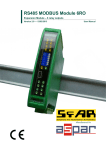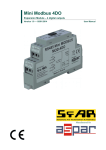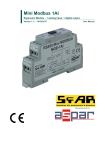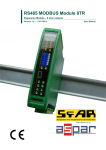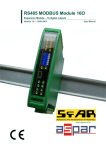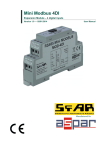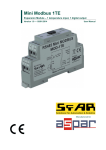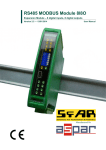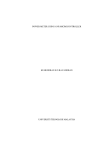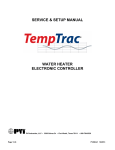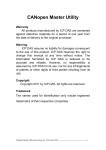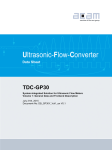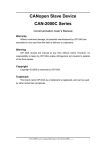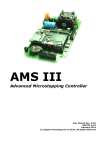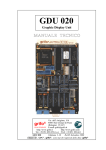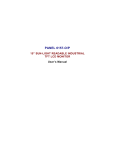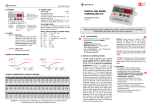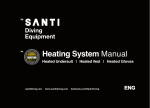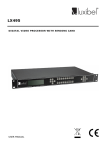Download SDM-6RO - ampero
Transcript
SDM-6RO Expansion Module – 6 relay outputs Version 1.0 — 5.02.2014 User Manual Manufactured for SDM-6RO SfAR User Manual Thank you for choosing our product. This manual will help you with proper support and proper operation of the device. The information contained in this manual have been prepared with utmost care by our professionals and serve as a description of the product without incurring any liability for the purposes of commercial law. This information does not release you from the obligation of own judgement and verification. We reserve the right to change product specifications without notice. Please read the instructions carefully and follow the recommendations contained therein. WARNING! Failure to follow instructions can result in equipment damage or impede the use of the hardware or software. Expansion Module – 6 relay outputs User manual © SFAR 2011-2013. All rights reserved. Version 1.0 - 5.02.2014 2 z 16 SDM-6RO SfAR User Manual 1. Safety rules • Before first use, refer to this manual • Before first use, make sure that all cables are connected properly • Please ensure proper working conditions, according to the device specifications (eg: supply voltage, temperature, maximum power consumption) • Before making any modifications to wiring connections, turn off the power supply 2. Module Features 2.1. Purpose and description of the module The SDM-6RO module is an innovative device that provides a simple and cost-effective extension of the number of lines of output with high current-carrying capacity. The module has 6 relay outputs. Each relay has three terminals: common (COM), normally open (NO) or normally closed (NC), so that the unit is very flexible. This module is connected to the RS485 bus with twisted-pair wire. Communication is via MODBUS RTU or MODBUS ASCII. The use of 32-bit ARM core processor provides fast processing and quick communication. The baud rate is configurable from 2400 to 115200. The module is designed for mounting on a DIN rail in accordance with DIN EN 5002. The module is equipped with a set of LEDs used to indicate the status of inputs and outputs useful for diagnostic purposes and helping to find errors. Module configuration is done via USB by using a dedicated computer program. You can also change the parameters using the MODBUS protocol. Expansion Module – 6 relay outputs User manual © SFAR 2011-2013. All rights reserved. Version 1.0 - 5.02.2014 3 z 16 SDM-6RO SfAR User Manual 2.2. Technical Specifications Power Supply Voltage 10-30 VDC; 10-28VAC Maximum Current* DC: 200 mA @ 24VDC AC: 250 mA @ 24VAC Maximum power consumption DC: 4.8W; AC: 6VA No of outputs Relay outputs Temperature Connectors Size Interface * 6 The maximum current and 5A 250V AC voltage (resistive load) 10A 24V DC Work -10 °C - +50°C Storage -40 °C - +85°C Power Supply 2 pins Communication 3 pins Outputs 2x 10 pins Configuration Mini USB Height 110 mm Length 62 mm Width 88 mm RS485 Up to 128 devices Maximum current with active Modbus transmission, all outputs on Expansion Module – 6 relay outputs User manual © SFAR 2011-2013. All rights reserved. Version 1.0 - 5.02.2014 4 z 16 SDM-6RO SfAR User Manual 2.3. Dimensions of the product Look and dimensions of the module are shown below. The module is mounted directly to the rail in the DIN industry standard. Power connectors, communication and IOs are at the bottom and top of the module. USB connector configuration and indicators located on the front of the module. 91 45 110 42,3 35 110 88 Expansion Module – 6 relay outputs User manual © SFAR 2011-2013. All rights reserved. Version 1.0 - 5.02.2014 5 z 16 SDM-6RO SfAR User Manual 3. Communication configuration 3.1. Grounding and shielding In most cases, IO modules will be installed in an enclosure along with other devices which generate electromagnetic radiation. Examples of these devices are relays and contactors, transformers, motor controllers etc. This electromagnetic radiation can induce electrical noise into both power and signal lines, as well as direct radiation into the module causing negative effects on the system. Appropriate grounding, shielding and other protective steps should be taken at the installation stage to prevent these effects. These protective steps include control cabinet grounding, module grounding, cable shield grounding, protective elements for electromagnetic switching devices, correct wiring as well as consideration of cable types and their cross sections. 3.2. Network Termination Transmission line effects often present a problem on data communication networks. These problems include reflections and signal attenuation. To eliminate the presence of reflections from the end of the cable, the cable must be terminated at both ends with a resistor across the line equal to its characteristic impedance. Both ends must be terminated since the direction of propagation is bidirectional. In the case of an RS485 twisted pair cable this termination is typically 120 Ω. 3.3. Setting Module Address in RS485 Modbus Network The following table shows how to set switch to determine the address of the module. The module address is set with the switches in the range of 0 to 127. Addresses From 128 to 255 can by set via RS485 or USB. Switch Adress SW1 +1 SW2 +2 SW3 +4 SW4 +8 SW5 +16 SW6 +32 SW7 +64 Ex. if switches 1, 3 and 5 are on than module addres is: Address = 1 + 4 + 16 = 21 Expansion Module – 6 relay outputs User manual © SFAR 2011-2013. All rights reserved. Version 1.0 - 5.02.2014 6 z 16 SDM-6RO SfAR User Manual 3.4. Types of Modbus Registers There are 4 types of variables available in the module. Type Beginning adress Variable Modbus Command Access 1 00001 Digital Outputs Bit 1, 5, 15 Read & Write 2 10001 Digital Inputs Bit Read 2 3 30001 Input Registers Registered Read 3 4 40001 Output Registers Registered 4, 6, 16 Read & Write 3.5. Communication settings You can restore the default configuration by the switch SW8 (see 3.5.2 - Restore the default configuration) 3.5.1. Default settings You can restore the default configuration by the switch SW8 (see 3.5.2 - Restore the default configuration) Boud rate 19200 Pariti Nie Data bits 8 Stop bits 1 Reply Delay [ms] 0 Modbus Type RTU 3.5.2. Restore the default configuration To restore the default configuration: • turn off the power • turn on the switch SW8 • turn on the power • when power and communication LED start blinking alternately than turn off the switch SW8 Caution! After restoring the default configuration all values stored in the registers will be cleared as well. Expansion Module – 6 relay outputs User manual © SFAR 2011-2013. All rights reserved. Version 1.0 - 5.02.2014 7 z 16 SDM-6RO SfAR User Manual 3.5.3. Configuration registers Modbus 40003 Dec 2 Hex 0x02 Name Baud rate 0 – 2400 1 – 4800 2 – 9600 3 – 19200 4 – 38400 5 – 57600 6 – 115200 other – value * 10 0 – none 1 – odd 2 – even 3 – always 1 4 – always 0 40005 4 0x04 Parity 40004 3 0x03 Stop Bits LSB 1 – one stop bit 2 – two stop bit 40004 3 0x03 Data Bits MSB 7 – 7 data bits 8 – 8 data bits 40006 5 0x05 Response delay 40007 6 0x06 Modbus Mode Expansion Module – 6 relay outputs User manual Values Time in ms 0 – RTU 1 – ASCII © SFAR 2011-2013. All rights reserved. Version 1.0 - 5.02.2014 8 z 16 SDM-6RO SfAR User Manual 4. Switches ON 1 2 3 Switch Function 1 Module address +1 2 Module address +2 3 Module address +4 4 Module address +8 5 Module address +16 6 Module address +32 7 Module address +64 8 Restoring default settings 4 5 6 8 Description Setting module address from 0 to 127 Restoring default settings (see 3.5.1 - Default settings i 3.5.2 - Restore the default configuration). Expansion Module – 6 relay outputs User manual 7 © SFAR 2011-2013. All rights reserved. Version 1.0 - 5.02.2014 9 z 16 SDM-6RO SfAR User Manual 5. Front panel removing To remove the panel and gain access to the switch, you must pry open the panel using a thin tool (eg a small screwdriver) as in the picture below. Expansion Module – 6 relay outputs User manual © SFAR 2011-2013. All rights reserved. Version 1.0 - 5.02.2014 10 z 16 SDM-6RO SfAR User Manual 6. Indicators Outputs 1 – 3 state Communication ON 1 2 3 4 5 6 7 8 mini USB configuration connector Power supply Outputs 4 – 6 state Indicators Power supply Description LED indicates that the module is correctly powered. Communication The LED lights up when the unit received the correct packet and sends the answer. Outputs state LED indicates that the output is on. Expansion Module – 6 relay outputs User manual © SFAR 2011-2013. All rights reserved. Version 1.0 - 5.02.2014 11 z 16 SDM-6RO SfAR User Manual 7. Module Connection SHIELD SUPPLY Expansion Module – 6 relay outputs User manual POWER SUPPLY © SFAR 2011-2013. All rights reserved. Version 1.0 - 5.02.2014 12 z 16 SDM-6RO SfAR User Manual 8. Modules Registers 8.1. Registered access Modbus Dec Hex Register Name Access 30001 0 0x00 Version/Type Read Version and Type of the device 30002 1 0x01 Switches Read Switches state 40003 2 0x02 Baud rate Read & Write RS485 baud rate 40004 3 0x03 Stop Bits & Data Bits Read & Write No of Stop bits & Data Bits 40005 4 0x04 Parity Read & Write Parity bit 40006 5 0x05 Response Delay Read & Write Response delay in ms 40007 6 0x06 Modbus Mode Read & Write Modbus Mode (ASCII or RTU) 40009 8 0x08 Watchdog Read & Write Watchdog 40013 12 0x0C Default Output State Read & Write Default output state (after power on or watchdog reset) 40033 32 0x20 Received packets LSB Read & Write 40034 33 0x21 Received packets MSB Read & Write 40035 34 0x22 Incorrect packets LSB Read & Write 40036 35 0x23 Incorrect packets MSB Read & Write 40037 36 0x24 Sent packets LSB Read & Write 40038 37 0x25 Sent packets MSB Read & Write 40052 51 0x33 Outputs Read & Write Expansion Module – 6 relay outputs User manual Description No of received packets No of received packets with error No of sent packets Output state © SFAR 2011-2013. All rights reserved. Version 1.0 - 5.02.2014 13 z 16 SDM-6RO SfAR User Manual 8.2. Bit access Modbus Address Dec Hex Address Address Register name Access Description 193 192 0x0C0 Default state of output 1 Read & Write Default state of output 1 194 193 0x0C1 Default state of output 2 Read & Write Default state of output 2 195 194 0x0C2 Default state of output 3 Read & Write Default state of output 3 196 195 0x0C3 Default state of output 4 Read & Write Default state of output 4 197 196 0x0C4 Default state of output 5 Read & Write Default state of output 5 198 197 0x0C5 Default state of output 6 Read & Write Default state of output 6 817 816 0x330 Output 1 Read & Write Output 1 state 818 817 0x331 Output 2 Read & Write Output 2 state 819 818 0x332 Output 3 Read & Write Output 3 state 820 819 0x333 Output 4 Read & Write Output 4 state 821 820 0x334 Output 5 Read & Write Output 5 state 822 821 0x335 Output 6 Read & Write Output 6 state Expansion Module – 6 relay outputs User manual © SFAR 2011-2013. All rights reserved. Version 1.0 - 5.02.2014 14 z 16 SDM-6RO SfAR User Manual 9. Configuration software Modbus Configurator is software that is designed to set the module registers responsible for communication over Modbus network as well as to read and write the current value of other registers of the module. This program can be a convenient way to test the system as well as to observe real-time changes in the registers. Communication with the module is done via the USB cable. The module does not require any drivers. USB PC Communication with the module is done via the USB cable. The module does not require any drivers. Configurator is a universal program, whereby it is possible to configure all available modules. Expansion Module – 6 relay outputs User manual © SFAR 2011-2013. All rights reserved. Version 1.0 - 5.02.2014 15 z 16 SDM-6RO SfAR User Manual Table of content 1. Safety rules.......................................................................................................................................3 2. Module Features...............................................................................................................................3 2.1. Purpose and description of the module.....................................................................................3 2.2. Technical Specifications...........................................................................................................4 2.3. Dimensions of the product........................................................................................................5 3. Communication configuration..........................................................................................................6 3.1. Grounding and shielding...........................................................................................................6 3.2. Network Termination................................................................................................................6 3.3. Setting Module Address in RS485 Modbus Network...............................................................6 3.4. Types of Modbus Registers.......................................................................................................7 3.5. Communication settings...........................................................................................................7 3.5.1. Default settings.................................................................................................................7 3.5.2. Restore the default configuration......................................................................................7 3.5.3. Configuration registers......................................................................................................8 4. Switches............................................................................................................................................9 5. Front panel removing.....................................................................................................................10 6. Indicators........................................................................................................................................11 7. Module Connection........................................................................................................................12 8. Modules Registers..........................................................................................................................13 8.1. Registered access....................................................................................................................13 8.2. Bit access................................................................................................................................14 9. Configuration software...................................................................................................................15 Manufactured for: Aspar s.c. ul. Kapitańska 9 81-331 Gdynia POLAND [email protected] www.ampero.eu tel. +48 58 351 39 89; +48 58 732 71 73 Expansion Module – 6 relay outputs User manual © SFAR 2011-2013. All rights reserved. Version 1.0 - 5.02.2014 16 z 16
















